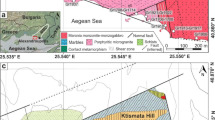Abstract.
Gold mineralization of the Hutti mine, southern India, is situated in closely spaced laminated quartz veins and associated alteration haloes along steeply dipping shear zones within a sequence of rather uniform amphibolites. Intense shearing has resulted in large-scale mylonitization of the wall rocks. Anastomosing shear zones, with intervening lensoid bodies of unsheared amphibolites, are characteristic features of the deposit. The general pattern of symmetrical alteration comprises a distal zone of chlorite-rich rock, with a proximal biotite-rich zone adjacent to laminated quartz veins. Arsenopyrite thermometry yielded a temperature range of 350–477 °C for the biotite alteration zone, which preceded the formation of the laminated quartz veins. Mass balance calculations on the alteration zones indicate a gradual mass and volume loss during alteration. The alteration is accompanied by intense potash metasomatism and addition of sulfur, which resulted in the formation of arsenopyrite, pyrrhotite, and pyrite. Results of fluid inclusion studies suggest that low salinity (3.9–13.5 wt% NaCl equivalent) H2O–CO2 rich fluids were responsible for gold-rich laminated quartz vein formation in the Hutti deposit. These fluids constituted a later counterpart of the protracted fluid activity that first formed the biotite alteration zone. The estimated P–T values range from 1.0 to 1.7 kbar at 280–320 °C. These data, along with the alteration assemblages and the characteristic gold–sulfide association, both in the altered wall rock and laminated quartz veins, suggest that gold, transported as reduced bisulfide complexes, was deposited in response to sulfidation reactions in the wall rocks. Comparison of P–T conditions of formation of gold–quartz veins at Hutti with two other large gold deposits in the eastern Dharwar Craton, namely Kolar (1.8 kbar/280 °C) and western Ramagiri (1.45–1.7 kbar/240–270 °C), indicates broadly similar lode-gold forming conditions in the Dharwar Craton.
Similar content being viewed by others
Author information
Authors and Affiliations
Additional information
Electronic Publication
Rights and permissions
About this article
Cite this article
Pal, N., Mishra, B. Alteration geochemistry and fluid inclusion characteristics of the greenstone-hosted gold deposit of Hutti, Eastern Dharwar Craton, India. Miner Deposita 37, 722–736 (2002). https://doi.org/10.1007/s00126-002-0257-8
Received:
Accepted:
Published:
Issue Date:
DOI: https://doi.org/10.1007/s00126-002-0257-8




